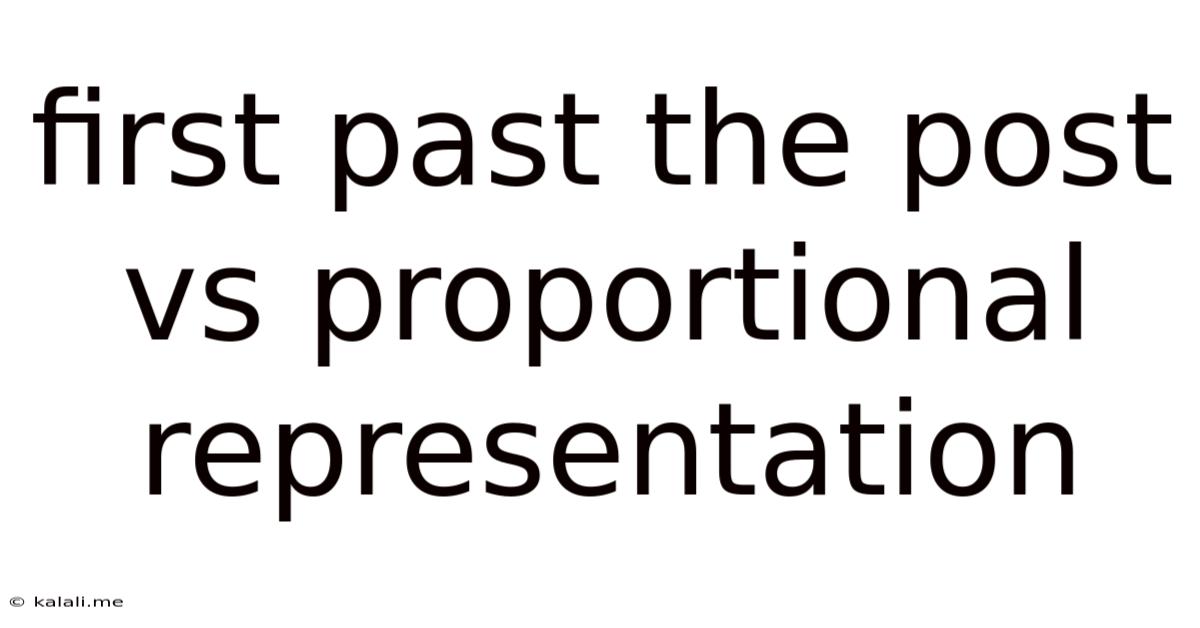First Past The Post Vs Proportional Representation
Kalali
Jun 11, 2025 · 3 min read

Table of Contents
First Past the Post vs. Proportional Representation: Understanding the Differences
Choosing a voting system is a fundamental decision for any democracy. Two prominent systems stand out: First Past the Post (FPTP) and Proportional Representation (PR). This article delves into the core differences between these systems, exploring their strengths, weaknesses, and overall impact on the political landscape. Understanding these distinctions is crucial for any citizen engaged in democratic processes.
What is First Past the Post (FPTP)?
FPTP, also known as "winner-takes-all," is a relatively simple system. Candidates compete in single-member constituencies. The candidate who receives the most votes in each constituency wins the seat, regardless of whether they achieve an absolute majority. This often leads to situations where a party can win a majority of seats even without securing a majority of the overall vote.
Strengths of FPTP:
- Simplicity: Easy to understand and administer, making it accessible to voters.
- Strong Government: Often produces governments with clear mandates and the ability to implement policies effectively. This system usually leads to a single-party government which has an easier time passing legislation.
- Constituency Focus: Elected representatives are directly accountable to their local constituents.
Weaknesses of FPTP:
- Disproportionate Results: A party can win a significant share of seats with a relatively small percentage of the national vote, leading to under-representation of smaller parties. This can lead to feelings of voter disenfranchisement.
- Wasted Votes: Votes cast for losing candidates are effectively wasted, failing to contribute to the overall political representation.
- Tactical Voting: Voters may feel compelled to vote strategically for a candidate with a better chance of winning, rather than their preferred candidate, undermining genuine voter choice.
- Two-Party Dominance: FPTP often favors larger, established parties, hindering the emergence and growth of smaller parties.
What is Proportional Representation (PR)?
PR aims to allocate seats proportionally to the votes received by each party. There are various types of PR systems, including party-list PR and mixed-member proportional (MMP). In party-list PR, voters choose a party, and seats are allocated based on the national or regional vote share. MMP systems combine elements of FPTP and PR.
Strengths of PR:
- Fairer Representation: Parties receive a number of seats roughly proportionate to their share of the vote, ensuring broader representation for diverse viewpoints and minority groups.
- Reduced Wasted Votes: Most votes contribute to a party's overall representation.
- Coalition Governments: Often leads to coalition governments, fostering collaboration and compromise across the political spectrum. This can lead to more inclusive policy-making.
- Increased Voter Turnout: PR systems may encourage higher voter turnout as people feel their vote has more impact.
Weaknesses of PR:
- Complexity: PR systems can be more complex to understand and administer than FPTP.
- Coalition Instability: Coalition governments can be less stable than single-party governments and may be prone to internal disagreements and collapse.
- Power Sharing: Power sharing arrangements in coalition governments can sometimes lead to policy gridlock.
- Smaller Party Influence: Small parties can exert disproportionate influence in coalition negotiations, potentially hindering efficient governance.
Conclusion:
Both FPTP and PR have their advantages and disadvantages. FPTP offers simplicity and strong government but can lead to disproportionate results and wasted votes. PR aims for fairer representation but can lead to complexity and coalition instability. The "best" system is a matter of ongoing debate, often reflecting differing societal values and political priorities. Understanding the nuances of each system empowers voters to make informed choices and participate more effectively in shaping their democracy.
Latest Posts
Latest Posts
-
If I Am 16 What Year Was I Born
Jul 01, 2025
-
Factors Of 30 That Can Add Up To 19
Jul 01, 2025
-
How Long Does Mail Take In The Same State
Jul 01, 2025
-
How Old Is Someone Born In 1962
Jul 01, 2025
-
How Many Yards Are In 60 Feet
Jul 01, 2025
Related Post
Thank you for visiting our website which covers about First Past The Post Vs Proportional Representation . We hope the information provided has been useful to you. Feel free to contact us if you have any questions or need further assistance. See you next time and don't miss to bookmark.